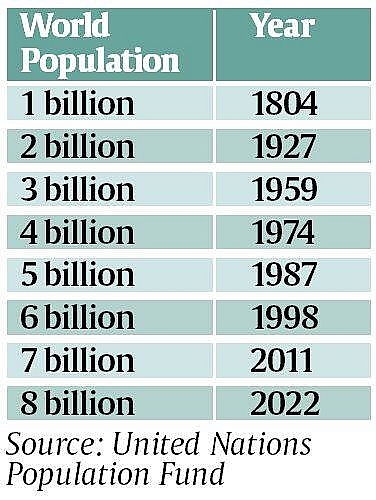What is the Most Populous Country in the World 2023: India to Overtake China
 |
| India population to overtake China in 2023 |
| Table of Content |
The Most Populous Country in the World in 2023
In 2022, the largest countries in the world in terms of population are China (1,425,887,337) and India (1,417,173,173), with both countries now having populations of well over a billion. The United States comes in third with just under 325 million residents.
The United Nations estimates India will overtake China as the world’s most crowded place in 2023. India’s population of 1.41 billion is a shade lower than China’s 1.42 billion, according to the UN. The UN report renewed calls for population control in India, where last year around 67,000 babies were born a day compared to 27,397 in China, which has a GDP six times larger than that of its smaller neighbour.
The UN projections say that by 2050, India’s population will reach 1,668 million, far exceeding China’s declining population at 1,317 million.
Two nations combined headcount will account for nearly 3 billion of the 8 billion people on the planet by next year.
 |
| Global Population |
The UN’s World Population Prospects report also predicts the global population will reach 8 billion on 15 November. It also estimates the global population could grow to 8.5 billion people in 2030 and reach 9.7 billion two decades later before peaking to 10.4 billion in the 2080s and then remain at that level until the turn of the century.
The COVID-19 pandemic also had an impact on overall population growth, bringing global life expectancy from 72.9 in 2019 to 71 in 2021 (but improvements in medication and health could bring life expectancy to 77.2 years in 2050), according to the report.
The world’s two most populous regions in 2022 were Eastern and South-Eastern Asia, with 2.3 billion people, representing 29 per cent of the global population, and Central and Southern Asia, with 2.1 billion (26 per cent). China and India accounted for the largest populations in these regions, with more than 1.4 billion each in 2022, says the report. Central and Southern Asia is expected to become the most populous region in the world by 2037.
The populations of 61 countries are expected to drop by 1% due to low levels of fertility. Around two-thirds of the global population lives where fertility is below 2.1 births per woman, which is around the level required for zero growth for a population with low mortality rates.
Increasing rates of migration also contribute to changing population patterns across countries. South Asia clocks some of the highest emigration trends, according to the report with India seeing an estimated net outflow of 3.5 million between 2010 and 2021. Pakistan has the highest net flow of migrants of 16.5 million during the same period.
| The 8 billion milestone is a "reminder of our shared responsibility to care for our planet and a moment to reflect on where we still fall short of our commitments to one another," UN Secretary-General António Guterres said in a statement |
Different Predictions
The 11 July announcement exceeded projections of a state-run panel which says India will overtake China as the world’s most populous nation by 2031, eight years later than the UN’s prediction made on World Population Day.
The National Commission on Population (NCP) report also said India's population will hold at 1.37 billion this year and hit 1.41 billion only by 2025.
Local experts backed the NCP calculations, which also warned Indian cities will see a baby boom while the rural population will shrink in the next 14 years.
In India, where National Family Health Survey 5 released last year found that India attained a Total Fertility Rate (TFR) of 2.0 for the first time, less than the replacement level of 2.1, and falling from a TFR of 2.2 in NFHS 4.
Falling Birthrate
The UN’s World Population Prospects 2022 report found the world’s population was growing at its slowest pace since 1950 because of falling birthrates. The world’s fertility rate has fallen from five births per woman in 1950 to 2.3 births per woman today. This is projected to fall to 2.1 births per woman by 2050, if not even earlier.
In 2021, the average fertility of the world’s population stood at 2.3 births per woman, having fallen from about 5 births per woman in 1950. Global fertility is projected to decline further to 2.1 births per woman by 2050.
Despite the continuing decline in the average number of births per woman, the total annual number of births has remained stable at around 140 million since the late 1980s “due to the youthful age distribution of the global population”. In 2021, 134 million babies were born worldwide. In the future, the number of newborns is expected to slightly increase to reach 138 million annually between 2040 and 2045, despite the continuous decline in the average number of births per woman. In 2021, most births worldwide occurred in the two most populous regions — Asia and sub-Saharan Africa.
Life Expectancy in the World
Worldwide, persons aged 65 years or over, outnumbered children under 5 years for the first time in 2018. This reduction of premature mortality for successive generations, reflected in increased levels of life expectancy at birth, has been a driver of population growth, the UN has said.
Globally, life expectancy reached 72.8 years in 2019, an increase of almost 9 years since 1990. Further reductions in mortality are projected to result in an average longevity of around 77.2 years globally in 2050 and the share of the global population aged 65 years or above is projected to rise from 10 per cent in 2022 to 16 per cent in 2050. By 2050, the number of persons 65 years and above are expected to be more than double that of 5-year-olds and the same as 12-year-olds.
TOP 10 COUNTRIES WITH THE HIGHEST POPULATION IN 2022
The ten countries with the largest population in the world today are China, India, United States, Indonesia, Pakistan, Brazil, Nigeria, Bangladesh, Russia and Mexico.
| ||||||||||||||||||||||||||||||||||||||||||||||||||||||||||||||||||||||||||||||||||||||||||||
 Top 25 most populous countries in the world Top 25 most populous countries in the world Now, China, India and The USA are ranked populous countries respectively. How about the other countries? Listed below is the top 25 largest countries in ... |
 Top 7 Most Populous Cities In the World Top 7 Most Populous Cities In the World The world's largest cities today fall under a class that researchers call "megacities," with a population of over 10 million people. With KnowInsider, let's check ... |
 Top 9 Biggest Countries in the World by Population (Updated) Top 9 Biggest Countries in the World by Population (Updated) Below you will find the most up-to-date list of population figures by country. Check out Top 9 Biggest Countries in the World - Most ... |























